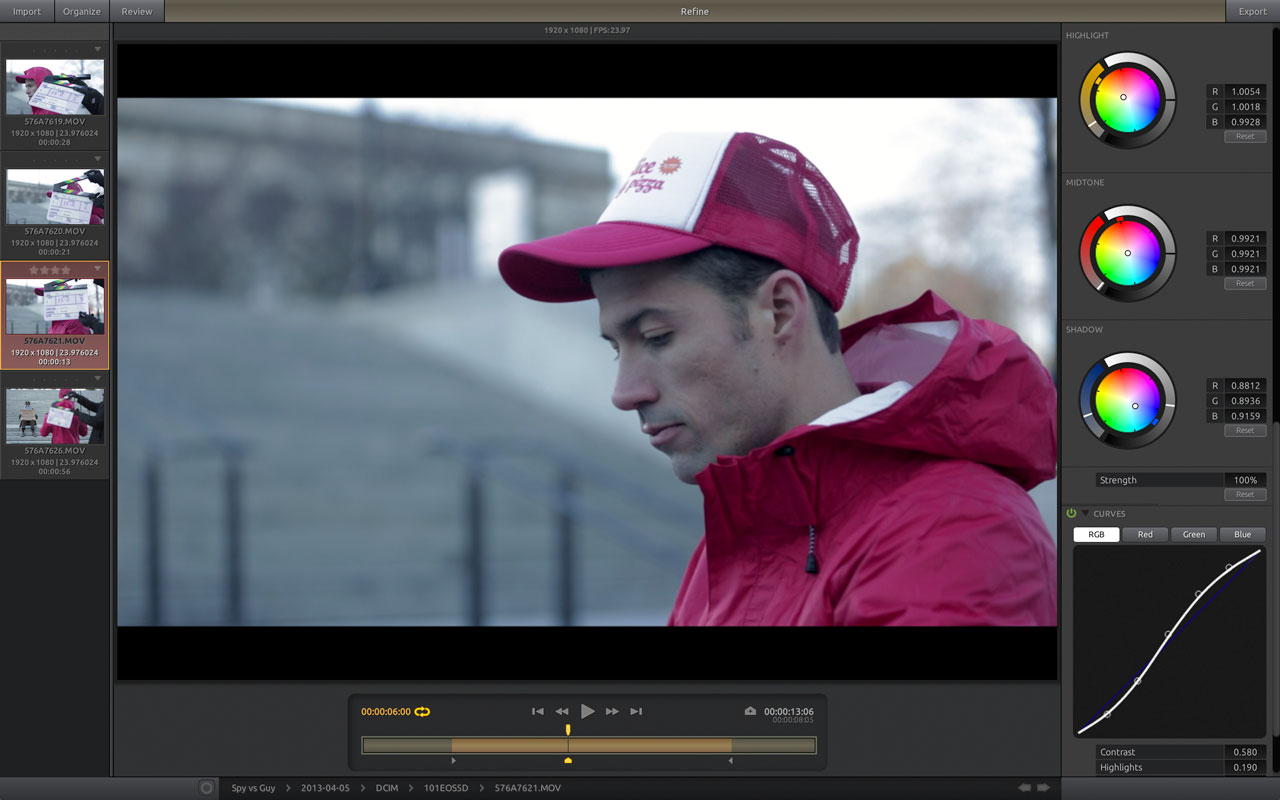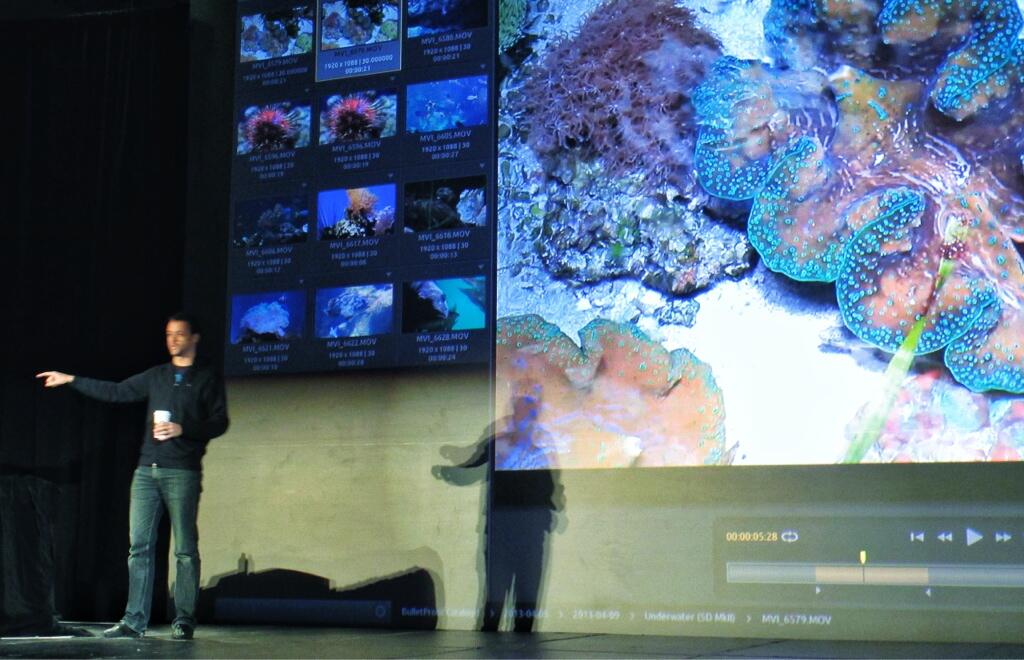BulletProof Unveiled
 Wednesday, April 10, 2013 at 11:28AM
Wednesday, April 10, 2013 at 11:28AM BulletProof is a new app from Red Giant that fills a huge gap in the DSLR shooter’s workflow. You’ve shot this great footage—now what do you do with it?
Large productions with high-end digital cinema cameras tend to be supported by a full DIT (Digital Imaging Technician) cart with customized software and hardware. But where was the DIT tool for indies? Red Giant saw an opportunity to bolster the workflow of one of the most common types of shoot—the DSLR-based, small-but-capable indie crew. So about 18 months ago, we sat in Sean Safreed’s dining room in San Francisco and started sketching ideas for BulletProof.

The Other Half of Your Camera
If you’re a cinematographer hired to create gorgeous images, you have a tough choice to make about how “flat” to shoot your footage. Flatter is better (log is best) for color grading, but your client might not understand why all their footage looks like it got a milk bath. And even if they do, who’s to say that they’ll color correct it anything like what you had in mind? Or maybe, to your horror, they’ll just fall in love with the “flat look,” since that’s what they’ve been looking at in the edit.
Or you could bake in a look into your shots in-camera. The client may love the dailies, but they also may be disappointed with the lack of flexibility you’ve given them down the line.
Now that we have an abundance of cameras that shoot a broad dynamic range, flat or log image, shooters need a way to not only review color-correct dailies on set, but also to begin the creative process of color correction—if only to “set a look” that conveys the cinematographer’s intent.
When I shoot stills or video, I’m already thinking about what kind of color grading I’m going to add later. Lensing the imagery only feels like the first half of the image-making process. That’s why we’re saying BulletProof is the other half of your camera—it’s a safe place to offload, catalog, and prep your footage for the edit. You can add keywords, markers, and other metadata—including Colorista primary color correction and a variety of industry-standard LUTs.
If you’re an indie filmmaker working on a small scale, you still have all the needs of a large production when it comes to managing your precious footage. You need a checksumed, redundant archiving process. You need to check your shots on set. And you might not have a dedicated script supervisor to take notes, so you need a way to mark your good takes, your crummy ones, and even key moments within a take—whether it’s you cutting the footage, or someone else.
BulletProof allows you to add markers and even in/out points to clips. This metadata is included in the clips your export, so your editor sees your Circle Takes, Rejects, and Notes right in their NLE, effortlessly.
Maybe the coolest feature is BulletProof’s Playlists. You can add shots to a playlist and they’ll play back in sequence, respecting the In and Out Points you’ve added to each clip. This makes it fast and easy to create a mini-cut on set, so you can check continuity and move on to the next setup with the confidence that you’ve got your coverage.
Like Red Giant’s Grinder before it, you can easily export all kinds of variations on your footage. You might create H.264 web-friendly movies with color correction and timecode window burn for web review, color-corrected ProRes files for offline edit, and uncorrected ProRes HQ movies for the online. All of this is driven by presets that you customize.
These are all wonderful features, but my favorite feature is that BulletProof is simple to use. I wanted to design something that would be intuitive and easy for a busy and distracted director to use on their own, yet powerful enough for a dedicated DIT to be a hero for their director or DP. The left-to-right “panoramic UI” makes it abundantly clear where your footage is coming from, where it’s going to, and what’s happening in between.
I’m really excited about BulletProof. I know it’s going to change how I shoot, and make my communication with my editors even better. But I know that we can’t do it alone. However much I might shoot, there are those of you out there who shoot more, and under more pressing conditions. So we’re launching BulletProof in a new way for Red Giant—as a free public beta. You can sign up now and help us shape BulletProof into the shooter’s companion app that you’ve always wanted. This summer, the app will ship for $199—a price designed to make BulletProof an easy choice for shooters at every level.
 Photo by @donaldberube. Note the tea.
Photo by @donaldberube. Note the tea.
One Froggy Evening
Last night I got to show BulletProof to over 1,000 people at the 13th annual SuperMeet. The crowd was very supportive even though I had almost completely lost my voice! I felt privileged to be representing the hard work of the amazing team at Red Giant who have been bringing BulletProof to life. If you’re at the show and you’ve come by the booth you’ll immediately understand why I love working with this company.
If you’d live to see more great NAB news, including Sean and I talking about BulletProof, check out fxguide’s amazing show coverage. You’ll find Mike Seymour interviewing us at about the 01:26:45 mark in Part 1.









Reader Comments (15)
Will BulletProof have the option for aspect ratio overlays? This is something I always felt was lacking in Grinder. It would be very helpful for 2.35:1 shoots.
Thanks.
Great idea Samuel, this is something I'd like as well.
Looks really cool but how does it differ from Adobe Prelude?
Is BulletProof Mac only?
Hi Pascal,
At first glance, BulletProof seems to occupy the same spot in the workflow as Prelude, but Prelude seems to have focused on very different aspects of ingest and logging, to the point where it strikes me more as an assistant editor's tool than an on-set DIT tool.
People would often ask me why they should buy Colorista if their NLE already comes with a 3-way color corrector. The only polite way I could answer that was to say that if I thought the 3-way color correctors that ship with NLEs were what I needed as a filmmaker, I wouldn't have bothered making Colorista.
My understanding is that the initial release of BulletProof will be Mac only, but a Windows version will follow shortly after. Red Giant showed BulletProof running on some badass Dell production laptops at the screening of Spy vs. Guy at NAB on Tuesday night.
How does the quality of DSLR transcoding compare to 5DtoRGB?
All that's required to match 5DtoRGB quality is to work at a good bit-depth and smooth the U and V channels a bit. I'd very much like to get that into BulletProof.
Wow, thanks a million Stu.
And interesting. That makes 5DtoRGB's magic sauce not seeem so magic. I'd certainly also like you to get that in BulletProof.
Shooting DSLR, I (we) are trying to inch out the best possible quality in the transcode. 5DtoRGB does a good spin on that, but certainly lacks the management of pre-edit material.
On another note, I really look forward to Beulletproof. I've personally been scanning the web for an app *just* like yours.
The closest I've come has been Aquafadas iDive which seems to have died out.
I think there are a lot of us out there with more material than we'd care to put in an NLE project, but still want to manage and tag somehow.
Good work RG!
Can't wait to try it on PC
Saw this at NAB and got the tour interface. Looks great waiting for BETA. This will make things go much quicker in the stuff I need to do. Especially for Stock work.
Since ProRes is not available for Windows, is it already known what codec will take its place in that version? Will there be some cooperation with GoPro/Cineform perhaps?
Will we also be able to bring in LUTs (or even .looks) to "grade" our shots?
Best
Yes, LUTs.
Here's a couple of things I really truly hope Bulletproof addresses. These are things that I rely on in my own workflow that have kept me from using a single tool, instead opting for a miss-mash of often clunky hacks....
- Timecode insertion for non-Canon: I shoot a D7000 and have to use the effective, albeit hideous, damn-near unusable but supremely useful, QTChange to take the time of day and use that to insert as a basic timecode for files. If Bulletproof did that, you've got one piece of my workflow simplified. It's why I never adopted Grinder (but tried it).
- Batch renaming and backup: If it can make duplicates of my original files onto my NAS and external drives, while renaming the files into something meanful (usually something like CamA01_yymmdd_hhmmss.mov based on file dates/times) then I'm sold and I can stop using Adobe Bridge for that solitary function.
And the big one....
- LTC to AuxTC: This is probably the biggest one though for democratizing multi-cam. MovieSlate iPad app functions as a slate (obviously) but can also be a Timecode Master synced to cheap iOS devices which can then push LTC into a stereo track on your cameras. The only problem is, only Avid supports LTC but Premiere and FCPX do not and need a $250 app (FCP AuxTC) for that one purpose. If Bulletproof took that approach, you could conceivably have a multi-cam sync'ed timecode solution for PENNIES on what it costs to buy even an appropriate number of LockIt Boxes. Extra points if you can get MovieSlate's log to attach to the files and convert your iPad based metadata into NLE meta data associated with the clip. Talk about killer app.
I can dream......
Looking at the upcoming cameras to be supported, I dont see the Lumix GH3. Would the GH3 work with BulletProof?
Thanks
Ray T
Denoising can be rather painful when exporting sequences and I'm thinking it would be useful to make this part of the ingestion process. I would love to denoise on the way to ProRes and not really think about it after that (i.e., in Premiere).
Even with draft mode, CUDA, etc., I still find myself toggling off the denoise effect on my high ISO takes and then on again after I've finished cutting and grading. Seems silly to do major computation like this on the fly.
Great stuff, can't wait for the beta.